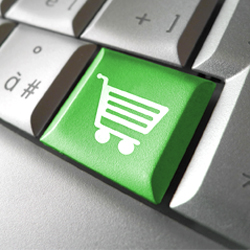1-877-332-3335|
 If you own a midsized retail chain, you must have a warehouse. In fact, we’d be worried if you didn’t. And we’re sure that your warehouse has worked out perfectly for your physical stores.
If you own a midsized retail chain, you must have a warehouse. In fact, we’d be worried if you didn’t. And we’re sure that your warehouse has worked out perfectly for your physical stores.
But then, you had this crazy idea to start selling products online and delivering them straight to customers’ homes. That’s when your warehouse stopped being that handy – at least, not for the online portion of your business.
Well, there’s a simple reason for that. A traditional warehouse is not configured for online distribution. In other words, it’s not a fulfillment center, which is what online retailers like Amazon use to accommodate their customers.
But, before you continue reading, ask yourself this – are you serious about fulfilling online orders? If your answer is yes, and you truly mean it, then your goal should be to create an effective fulfillment center. Yes, it’ll be costly and logistically taxing, but in the long run, it will be worth it. Trust us.
Here are the steps:
Step 1: Understand What a Proper Fulfillment Center Looks Like
The first thing you want to do is understand the key differences between a fulfillment center and a traditional warehouse. Here are some of them:
As you can see, warehouses and fulfillment centers have many fundamental differences. The key to success is fully committing to the requirements of a fulfillment center. If you don’t see your business accommodating these requirements, then the online portion of your retail operation won’t get too far.
Step 2: Decide How Much Space You Need
If you’re still onboard with committing to a fulfillment center, you need to decide how much space you’re willing to devote to it. Since you’re just starting out, we recommend leaning toward the conservative side on this, to minimize your losses in case of failure.
There are several important factors to consider:
The demand for spaces like this is very high – especially in well-populated areas – so consider your requirements carefully. If one of your current warehouses can be used for this, consider doing so instead of renting or buying a new location.
Step 3: Figure Out How to Effectively Process Orders
To ensure your fulfillment center is effective, you need to have a good system in place for processing online orders. There are two components to this:
We also recommend providing tracking information to give the customer an idea of when they can expect their order.
Step 4: Arrange Frequent Pickups
To deliver your products effectively, you need to have a relationship with at least one shipping carrier. Depending on your volume, you may need to partner with several carriers to ensure each order gets delivered on time.
As we mentioned before, crowdsourced shipping is a great option if you want to offer fast delivery at a relatively low cost, since this method relies on networks of local, non-professional couriers to deliver packages.
Carriers need to be able to pick up shipments on a daily basis to ensure maximum efficiency. Depending on the carrier, they may need to pick up shipment at a certain time of day to guarantee a specific delivery timeframe. Others may be more flexible. Either way, it’s important to be aware of what a carrier can and cannot do.
Step 5: Ensure Good Inventory Management
This should go without saying, but your fulfillment center will need impeccable inventory management, especially if your volume of orders is high. You have to place items in their respective bin, shelf and pallet – as well as keep track of them in real time.
Since the turnover is incredibly high, you and your managers need to make sure that things end up where they are supposed to and nothing is lost or stolen. You also don’t want to discover that you’re out of stock after the customer places their order. Check out this article for more information on inventory management.
Step 6: Automate Your Fulfillment Management
As you can tell already, the logistics of running an effective fulfillment center can be challenging. There are a lot of moving pieces that interact with each other, so you need to make sure they all co-exist seamlessly.
Given that you already have a retail chain to worry about, managing a fulfillment center may not be something you want to worry about. But, as you probably already know, people love ordering online, so you shouldn’t turn back just because it seems tough to manage.
The truth is that, with the right technology, you can build an amazing fulfillment center. Using a modern ERP system, you can keep track of every step in your fulfillment process in real time and ensure everything is proceeding as planned.
You can also integrate your ERP system with your eCommerce platform, so that whenever a customer places their order, it gets automatically sent to your fulfillment center where it can get picked, packed and shipped.
We already know a system that can help you – Magstar Total Retail. If you’d like more details, come by booth #4244 during NRF 2020 and speak with us directly.
Toronto, Ontario, Jan 3, 2019 – Magstar Inc., an ERP software leader in the midsized retail marketplace, has once again been recognized as a top 20 software vendor in the 2019 RIS News Software LeaderBoard Survey – 19th year in a row.
Magstar appeared in the survey’s 11 categories, ranking highly in Technology Innovation, Ease of Installation & Integration, Quality of Support, Quality of Service and several others.
“I think our highest-ranked categories speak volumes about our values as a company,” said Steven Greenwood, President of Magstar Inc. “We always do our best to be there for our customers when they need us. I believe that the people and the service behind a product are just as important, if not more so, as the product itself.”
The purpose of the annual RIS Software LeaderBoard survey isn’t simply to identify which vendors are the best, but to pinpoint each vendor’s greatest strengths, whether it’s the quality of their service, product or overall performance. With such a great variety of categories, customers stand a much better chance of finding a vendor that suits their exact needs.
“Magstar has been a consistent top 20 vendor in the RIS LeaderBoard for 19 years in a row now, and 2019 is no exception,” said Joe Skorupa, RIS’ Editorial Director of RIS News. “This level of consistency should reassure any prospective customer that Magstar is a successful and reliable company. I would like to congratulate everyone at Magstar for their commitment to delivering top-notch customer satisfaction and LeaderBoard results year after year.”
One of the biggest reasons why Magstar is able to maintain such a high level of service and support is because it doesn’t rely on call desks or offshore call centers. Every customer has their own dedicated account manager, available 24/7. That’s how Magstar keeps its customers happy – and the rankings prove that this approach works.
About Magstar
For over 30 years, Magstar has been helping midsized retailers integrate operations and synchronize workflow with multichannel ERP and POS solutions made explicitly for specialized retailers. With an end-to-end solution that addresses unique industry needs, retail chains can automate processes, gain inventory visibility and outshine competitors.
 As you already know, online shopping is a big deal. We probably don’t even have to throw any stats at you to prove it, but here ‘s one anyway – according to BigCommerce, 96% of Americans with internet access have made an online purchase in their life, 80% in the past month alone.
As you already know, online shopping is a big deal. We probably don’t even have to throw any stats at you to prove it, but here ‘s one anyway – according to BigCommerce, 96% of Americans with internet access have made an online purchase in their life, 80% in the past month alone.
As a traditional midsized retailer, you can view this either as a cataclysmic problem – or an opportunity to make even more money. We prefer the latter. However, that doesn’t mean that your only solution is to somehow become an online retailer. Instead, it should be to combine online and offline shopping experiences into one – the omnichannel experience.
Here’s another fact for you – traditional in-person retail shopping isn’t dying, as some may believe. According to a report from IHL Group, 2017 saw a net increase in physical store openings of over 4,000, meaning that for each company closing a store, there were 2.7 companies opening new stores. People like traditional stores, but they are also lazy. That’s why they shop online.
You might’ve heard about the supposed benefits of the omnichannel experience before. We’re not here to talk about those. After all, chances are you already know the key benefit – more sales and more money. But, what good are those benefits if you can’t even get started with omnichannel?
That’s why we want to walk you through all the basic steps first – and potentially offer a consultation.
Step 1: Evaluate What You Have
Before committing to an omnichannel experience, you need to know what aspects of it you’re already offering.
First and foremost, see if you’ve already done the following:
Most retailers these days already rely on a search engine profile, social media account and website to drive their business. That said, having them all does not automatically mean you offer an omnichannel experience – because they need to be seamlessly connected to your instore experience. That’s where the next step comes in.
Step 2: Make Sure You’re Able to Sell Online
You may already have a simple website that explains what your business is all about, with all your locations and their details listed. That’s a good start – but not enough to entice the modern consumer.
What your website needs is to be a proper online store where customers can order and pay for your products. You don’t need to sell all your products here – at least not right away – but you need to allow customers to buy your products without entering your physical store, if they want to.
So, what does that entail exactly? Well, to start, your website needs to be able to do the following:
Step 3: Offer Instore Pickups for Online Buyers
Once you start taking customers’ money online, you will need to be able to provide the goods. If you’re not yet set up to deliver products en masse, you have the next best thing – your stores. You can get your customers to make an online payment and then come into one of your stores to pick up their purchase.
The product does not need to be at the location the customer will choose for their pickup at the time of purchase, because you can always have it delivered there. Just be sure to clearly communicate when, how and where the customer can pick up their purchase before they pay for it. You don’t want to come off as manipulative.
Step 4: Offer Online Deliveries
Once you start rolling with your online sales and instore pickups, the next step is to start delivering products to your customers’ homes.
What’s important to understand about deliveries is that you need to be able to do them fast. Back in the day, you could afford to take four or more weeks deliver something, but it’s no longer possible – thanks to same-day deliveries by outlets such as Amazon.
One way of offering same-day deliveries is by relying on crowdsourced shipping since this method of fulfillment involves networks of local, non-professional couriers to deliver packages. The big benefit of this method is its relatively low cost.
Step 5: Simplify Returns
Once you start delivering products, you should also streamline returns. This is important because an online purchaser isn’t typically inclined to drive all the way to a store to make a return. They’d rather just send it back and get a refund.
The first step toward streamlining returns is making them free. To do this right, set up your free returns on your terms by choosing the least expensive shipping solution. If the buyer isn’t interested in going through your preferred vendor, then they can pay for their own.
With Amazon, for example, a customer can select one of several free return shipping methods, print a shipping label and attach it to their return package. After that, they just need to take it to the nearest shipping location, get it scanned and go home. Alternatively, the customer can opt out of a free shipping option and pay for it with their money.
You need to offer something similar if you want to be competitive in this market.
Step 6: Ensure Your Inventory is Omnichannel-Ready
You will also need to adjust your inventory management tactics to make online and offline sales work in tandem. You don’t want your physical locations to be undersupplied in favour of your online store – and vice versa.
To get a detailed list of tips on how to adjust your inventory management for an omnichannel experience, check out this article.
Step 7: Embrace Automation
By the time you reach this sentence, you might be thinking, “How in the world can I get all this done?”
Well, the answer to that is simple – you can’t. At least, you can’t do it right now. If you’re imagining hiring an intern or someone along those lines to painstakingly upload your products to your website one by one and then update their information on a regular basis, then stop. This is not the way.
What you need is a solution that can automate a significant portion of these activities. There is a way to have all your inventory information uploaded to your website with a click of a button.
To do that, you need a system that syncs the information on your website with the product information for your stores and warehouses. That way, whenever something changes, such as pricing for example, the website gets automatically updated as well.
We have a solution in mind – Magstar Total Retail. So, if you’d like to see how it works, just reach out to Steven Greenwood, Magstar President, and he’ll be happy to show you.
 Online shopping has changed the way we buy products – no doubt about it. It has also made inventory management a far bigger challenge for most modern retailers.
Online shopping has changed the way we buy products – no doubt about it. It has also made inventory management a far bigger challenge for most modern retailers.
And that’s because many modern consumers expect to get their product on the same day, especially when they’re visiting a physical store.
You can safely “blame” this on Amazon. With an Amazon Prime account, a customer can make a purchase, and have the product delivered to their home in one or two days. And no, not business days – days. For instance, if you buy something on Friday, you can have it in your hands by Saturday morning. Often, customers can even have a product delivered to them on the same day.
You might wonder – if that’s how online shopping works now, how can midsized retailers even stand a chance? Well, you’d have to make a few big adjustments to your inventory management to ensure you can fulfill customer expectations as effectively as Amazon.
Here are some of the biggest ones:
Make sure you have enough items in stock to accommodate the demand. As basic as this may sound, it’s not always easy.
Here are a few things you can do to make sure you have enough product on hand:
While this will require some research beforehand, along with continuous re-evaluation, you’ll be able to satisfy more customers, and in turn, make more money.
Whether you like it or not, any of these issues can and will affect your store chain at one point or another. So, it’s much better to be ready for them instead of scrambling to fix them when they occur.
When predicting your future sales, be sure to account for the latest trends in the market, previous year’s sales for each week, guaranteed sales from regulars, seasonality and the overall economy.
No matter how hard you try, being out of stock is inevitable, especially if the item is not a popular seller. In this case, make sure your customers don’t walk into any of your stores expecting the item to be in stock. That will likely just infuriate them and drive them straight back to Amazon.
How do customers get this “crazy” idea that you have the right product on hand? Your marketing. If you have a flyer advertising an out-of-stock product, phase it out. If your website lists items that are out of stock without labelling them as “out of stock,” change that. If you have online ads showcasing the products you currently don’t have, fix them.
You get the point. Don’t mislead your customers into thinking you have what you don’t actually have, even if you can order it for them when they enter the store. It comes off as disingenuous, and customers hate that.
All right, so what if – despite your best efforts – you do end up with a customer that wants something you don’t have? Tell them that you’ll order the item for them and have it delivered either to the store or the customer’s door.
An online-savvy customer (hint: most of them) may still not like the idea. They may want the item either on the spot, or at the most, on the next day. If you can’t accommodate that, you risk losing the customer to Amazon. Why? Because Amazon provides same-day deliveries.
One way of offering same-day deliveries is by relying on crowdsourced shipping, which is a method of fulfillment that involves networks of local, non-professional couriers to deliver packages to customers’ homes. The benefit of this method is that you can get items to customers in a matter of hours at a relatively low cost.
So, look around – the options to make quick deliveries work are all around you. After all, Amazon is already doing it.
Make returning a product easier. Depending on how many locations you have, going to your store physically may not always be the easy option.
So, if you already sell your products online in some fashion, make sure your customer can return your products by mail instead of just dropping them off in person.
This is yet another process Amazon has made easier. Back in the day (but not too long ago), customers had to print their own return shipping labels and pay for return shipping with their own money. Not anymore, and not with Amazon. Now you get a printable return shipping label, and along with it, free return shipping.
You need to offer the same, if you don’t intend to rub your customers the wrong way – especially since returning a product is already a somewhat unpleasant process.
Okay… I Want Better Inventory Management, But How?
After reading all of the above, you might be nodding your head and thinking, “Yes, I do need to improve my inventory management.” However, you might also be thinking, “But, what’s suggested here is not feasible.”
The latter is only true if you don’t have the necessary tools. Luckily, Magstar Total Retail offers those tools to midsized retailers. So, if you’d like to see how they work, Steven Greenwood, Magstar President, can show you. Book a Chat with Him Right Now!
With major store chains like Toys “R” Us going out of business, many brick-and-mortar retailers are terrified that they may be next. The most common fear is that physical stores simply cannot compete against their online counterparts.
This is actually a huge misconception. According to a report from IHL Group, 2017 saw a net increase in store openings of over 4,000 – meaning that for each company closing a store, there were 2.7 companies opening new stores.
Of course, many of those businesses likely also have a strong web presence. After all, according to a report from BigCommerce, at least a quarter of online shoppers have made an online purchase from a brick-and-mortar store in 2018. In other words, online and offline shopping experiences are converging into one – or what’s dubbed as “multichannel retailing.”
 So, if you’re worried that your midsized brick-and-mortar chain might soon follow the likes of Blockbuster, your best bet is to strengthen your online presence and then fully synchronize it with your physical operations.
So, if you’re worried that your midsized brick-and-mortar chain might soon follow the likes of Blockbuster, your best bet is to strengthen your online presence and then fully synchronize it with your physical operations.
To help you get started, the President of Magstar, Steven Greenwood, has shared several key tips on how to successfully transition to multichannel retailing in our latest interview with him:

What are some of the challenges of a brick-and-mortar store that hasn’t embraced multichannel retailing?
Steven: “In today’s environment, a brick-and-mortar retailer – as a single entity or as a group of stores – is faced with a number of challenges.
The first challenge is always inventory – being able to ensure that they have the proper assortment of products at each individual location. This is often a risk and a large investment.
The other big challenge is that today’s consumer isn’t always able or willing to take the time to get to a brick-and-mortar store – regardless of whether they are using public transit or their own car – since they have to work around store hours. They don’t want to be told when, where or how they can shop. So, they are looking for the flexibility that meets their timeframe, their demands and their purchasing needs.
The other challenge for brick-and-mortar retailers is having the proper staff who know the inventory and how to serve their customers.
All of these challenges combined make running a brick-and-mortar store very difficult, particularly without the multichannel experience.”
What are some of the benefits of multichannel retailing?
Steven: “Multichannel retailing allows stores to present their product to any type of customer – whether they are brick-and-mortar, web-only or a combination of the two.
For example, one of the challenges that a web-only retailer faces is managing product returns. If the retailer has a brick-and-mortar store as well as a website, as a consumer, I have the ability to purchase something on the web, and if it’s not what I want, I can walk into any of their locations and exchange it.
That way, I develop a relationship with that retailer and I can then be engaged in all the different aspects of the retail environment, whether it’s online, brick-and-mortar or consolidated.
All that comes into play when you’re offering the multichannel customer experience.”
 What are the challenges of transitioning to multichannel retailing?
What are the challenges of transitioning to multichannel retailing?
Steven: “The biggest challenge is delivering a good web experience.
For example, when a retailer with just a brick-and-mortar store, designs their warehouse or distribution center, they design it to handle distribution in the way that suits their store and packaging needs, which means that they usually ship and package their products in bulk to cut on costs and ensure each store has enough items to meet consumer demand.
When they are offering the multichannel experience or working in a web environment, their distribution center has to be able to handle and ship products individually – and have the staff who can adjust to this process of order fulfillment.”
What are the steps that a retail business will need to go through in order to transition successfully?
Steven: “The retailer would have to first determine how they are going to distribute their services across the different channels.
For instance, are they going to offer the same products on the web as in their brick-and-mortar stores? Or are they going to enhance their offering, so that they can offer more products than what they have in their brick-and-mortar stores because they can make them web-only?
Then, there’s the question of how they are going to track their customers. Are they going to maintain consolidated customer history files? Or are they going to segment them, so that the consumer can be identified based on whether they shop in the store, online or both?
Product allocation is another concern. You don’t want to put products on the web that you no longer have because you’ve already distributed them to all your stores.
Those are some of the things that the retailer has to plan out before they can even start moving to the web.”
 How can ERP software help with this transition?
How can ERP software help with this transition?
Steven: “An ERP solution, by design, handles multiple different facets of the retail operation. This forces the retailer to ensure that they have a uniformed database, a uniformed package that is being shared by all aspects of the business.
So, if I already have an ERP system where I have one central database that is managing my promotional, product, price and customer files, as well as my supply chain, then I already have a distribution plan, and all my stores know when various promotions, products are coming in, so that they can prepare for them.
The web becomes just another store in that environment, where it can now be part of that entire chain of business decisions.”
What specific capabilities retailers need to look for in an ERP package if they want to transition to the multichannel experience?
Steven: “Well, again, you don’t want to manage multiple databases. You don’t want to be required to have one database for your web store and one for your brick-and-mortar location. You don’t want to have two price files. You don’t want to have two customer files.
For example, you have this trend today of ‘click-and-pick.’ What that means is that a customer can go on the web, purchase something, and at that time, decide whether they want it shipped to their home or if they want to pick it up at the store in person.
If, as a retailer, I’m running an ERP solution that consolidates all my data, it’s very easy for me to arrange both, because my warehouses and stores are synchronized to deliver whatever the customer wants.
You don’t want to have many different silos, and a proper ERP system should be able to knock those barriers down and allow the retailer to centralize their entire operation.”
What advice would you give to retailers looking to transition to the multichannel experience?
Steven: “The main advice I can give any retailer is, make sure you know, before you start, what you want and where you want to end up, because you cannot go into this and then realize halfway through that you did not cover all your bases.
You want your web presence to be in perfect harmony with your brick-and-mortar presence, so that the consumer can clearly identify you as a multichannel retailer – not just as a brick-and-mortar store that also sells on the web, or a web retailer that also has a brick-and-mortar location.
The consumer needs to see the same consistent messaging, regardless of what channel they purchase from.”
Are You Ready for Multichannel Retailing?
If you run a midsized retail chain and firmly believe that you need multichannel retailing to compete, then consider checking out our ERP software since it was specifically designed for retailers like you. Steven Greenwood would be happy to show you how it all works – and how you can use it to make the transition.